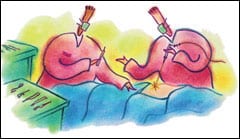 |
Preventing surgical-site infections (SSI) through protective measures taken before, during, and after surgery leads to improved patient care, contributes to greater patient-satisfaction levels, and provides for more favorable results.
Statistics reflect the need for everyone to take a closer look at SSI.
For example, SSI are, statistically, the second- to third-most common types of infections that crop up in hospitals. In addition, SSI can double the likelihood of death as well as run the risk of increasing hospital stays for patients by 6.5 to 17 days. Finally, victims of SSI are 60% more likely to require treatment in the intensive care unit.
Several types of factors increase the risk for infection during surgery.
HOST DYNAMICS
Age, morbid obesity, malnutrition, diabetes, immunosuppression, and cigarette smoking are all host factors that increase the chances of SSI. It is in the patient’s and surgeon’s best interest to reduce any of these factors prior to surgery.
Ask the patient appropriate questions to elucidate any of these factors. Also, it is important for the patient to disclose these factors to the surgeon. For example, most smokers would prefer to quit smoking knowing the risks associated with surgery and smoking. Yet, the addiction is difficult to overcome without the help of others, such as a plastic surgeon who can help motivate a smoker to quit for surgery.
ENVIRONMENTAL AND SURGICAL TRIGGERS
When operative time is greater than 2 hours, there is an increasingly likelihood that SSI will develop.
Surgical preparation may affect the likelihood of SSI. Razor-shaving the body increases the risk of SSI to 5.6%. Clipping when compared to shaving reduces the risk of SSI from approximately 5.6% for shaving to 1.7% for clipping.
Clipping in proximity to the incision is preferable, and if it is not necessary then do not use any hair-reduction procedure prior to surgery. Advise patients to avoid shaving the surgical site for 2 weeks prior to surgery.
Nicks and scrapes from shaving will result in colonization with microbes and can result in an increased rate of SSI. In addition, prep showers using chlorhexidine reduce the risk of SSI.
The use of drains may increase the risk for infections as well.
Certain medical conditions that may occur during surgery—including hypothermia, the need for perioperative O2, and excessive blood loss—may increase the chance of infection. Finally, the surgeon’s skill, the volume or the amount of surgery performed, and the location of the surgery on the body play a role in the appearance of SSI.
ENDOGENOUS FLORA/MICROBIAL ISSUES
Catheters, instrumentation, micro-organic changes resulting from disease, malnutrition, and hormone changes may contribute to SSI.
Other factors that play a role in SSI include oxygen levels, pH levels, and reactions of other microorganisms with the host site.
PROPHYLACTIC ANTIBIOTIC PROTOCOLS
The risk of SSI deriving from surgical procedures—such as those associated with implants—can be effectively reduced with the use of prophylactic antibiotics administered intravenously at an appropriate time and dosage, according to guidelines produced by the American Society of Health-System Pharmacists in 1999.
In fact, the timing and dosage of prophylactic antibiotics is particularly important. Higher infection rates are demonstrated when an antibiotic is administered more than 60 minutes before the incision, at the time of the incision, and after the incision is made.
The Centers for Disease Control and Prevention and the Centers for Medicare and Medicaid Services joined together—with the help of eight medical organizations—to establish the Surgical Infection Prevention Project to better define terms to prevent infections.
Though not concrete for aesthetic surgery, the following denotes some suggested protocols for the prevention of SSI:
Timing of antibiotics—Administration of antibiotics should be completed prior to the placement of a tourniquet, and between 30 minutes and 1 hour before the first incision is made. Vancomycin and fluoroquinolones should be administered less than 1 hour and more than 30 minutes before the incision.
Duration of antibiotics—It should not exceed 24 hours, except in the case of cardiothoracic patients or in other specific cases.
Second dose exceptions to the rule—A second dose of the B Lactum antibiotic may be administered during surgeries that are more than 3 hours in duration, or for blood loss in excess of 1,500 cc.
Weight-based drugs—There is a certain level of variance described for appropriate dosage in weight-based drugs. Patients weighing more than 80 kilograms (176.3 pounds) may receive 2 grams of select antibiotics, including cefazolin, cefoxitin, cerfuoximine, and/or aztreonam.
Allergic reactions—Persons susceptible to B Lactum allergic reactions are best served with alternatives, such as uricaria, pruritus, angioedema, bronchospams, hypotension, and arrhythmias.
Surgical drain use—The use of surgical drains should involve adding supplemental O2 at 80% versus 30% early in surgery and at postop. The results can be a decrease in SSI by a factor of two.
HYPOTHERMIA PREVENTION
Preventing hypothermia may reduce the SSI risk by threefold.
Intraoperative hypothermia is defined as core temperature of less than 96.8°F (36°C). This occurs because of numerous factors, including general or regional anesthetic drug administration, surgical procedures involving exposed cavities, and cold fluid infusion.
Within the first hour of a surgery involving general anesthesia, unwarmed patients lose approximately 1.6°C. In addition, more than 80% of this temperature continues to decline during the 2 hours after administration of anesthesia. By 3 to 5 hours, the body temperature can sit at a dangerous level, presenting several additional risks, including SSI.
Precautions should be taken to prevent hypothermia in the preoperative and postoperative phases of care. This includes actively warming the patient via a heated humidifier in the ventilator breathing circuit, warm blankets, thermal drapes, fluid warmers, and forced-air warming.
Apparently, there is a relationship between hyperglycemia during the first 48 hours following surgery and an increased risk of SSI. In the prevention of medical-condition complications, blood glucose control appears to have value in the reduction of SSI.
In hospitals with high methicillin-resistant Staphylococcus aureus infection rates, the Health Insurance Counseling and Advocacy Program recommends the administration of vancomycin prophylaxis to help reduce the risk of infection.
|
See also “Surgical Strategies for the Body” by Dan Yamini, MD, and Steven Svehlak, MD, in the May 2005 issue of PSP. |
CONCLUSION
Although a patient’s daily habits and medical conditions play a role in the prospect of SSI, plastic surgeons should do a thorough history and conduct a physical in order to attempt to improve as many of the medical conditions as possible preoperatively.
Using the suggested recommendations to reduce SSI may help to produce better patient outcomes and will create higher satisfaction levels among patients in your practice.
It is important to note that the abovementioned protocols are not written in stone, as many interested organizations continue to develop and enhance protocols for SSI.
Richard J. Greco, MD, is board certified in both general surgery and plastic and reconstructive surgery, and has also earned a Certificate of Added Qualifications in hand surgery. He has published more than 30 scientific works on plastic surgery, including six chapters for medical textbooks. Greco was an assistant professor at the University of Pittsburgh School of Medicine. His research has resulted in two patents and led to new surgical practices. He can be reached at .




